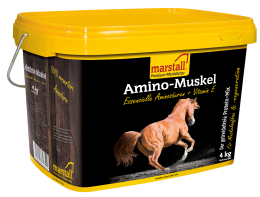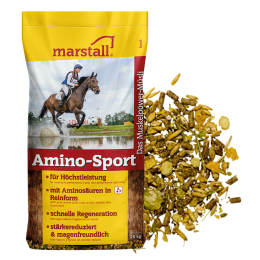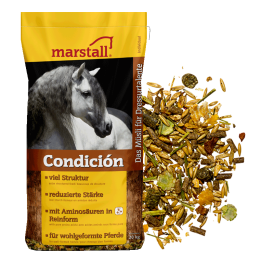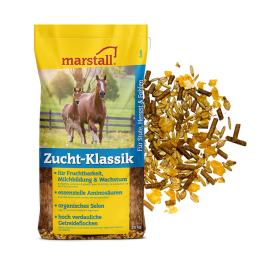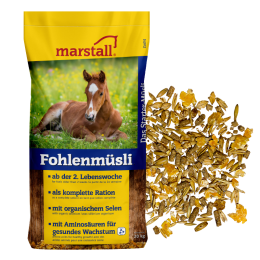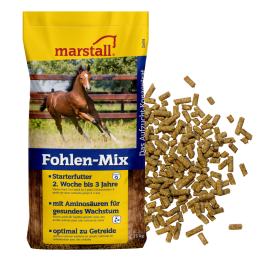Why do horses need amino acids?
Amino acids are a component of the feed ration which, in addition to many other processes in the horse's body, is particularly important for muscle building. Which amino acids are particularly important for horses? What do they do to the muscles? What should I pay special attention to when feeding?
- What are amino acids used for?
- How do horses utilize proteins?
- What are essential amino acids?
- What are first limiting amino acids?
- Which feed covers the demand?
- What are the advantages of pure amino acids?
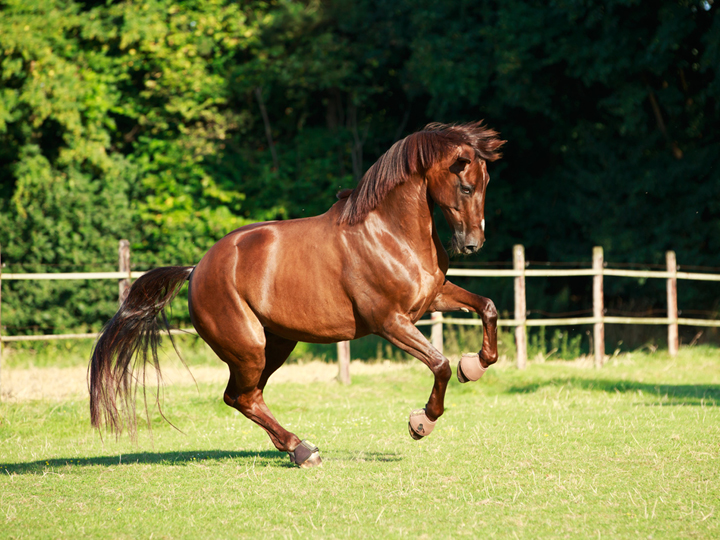
What are amino acids used for?
Amino acids are the building blocks of proteins. They are extremely important for the horse's organism. And not only in muscle building, but also for many other processes. They are important for hoof and hair growth, for connective tissue and bones, for messenger substances in the brain and nervous system, for cell generation throughout the body and for the production of milk and sperm, for example. All in all, this means that amino acids are immensely important for all cellular processes in the horse's body. They are the "building blocks of life".
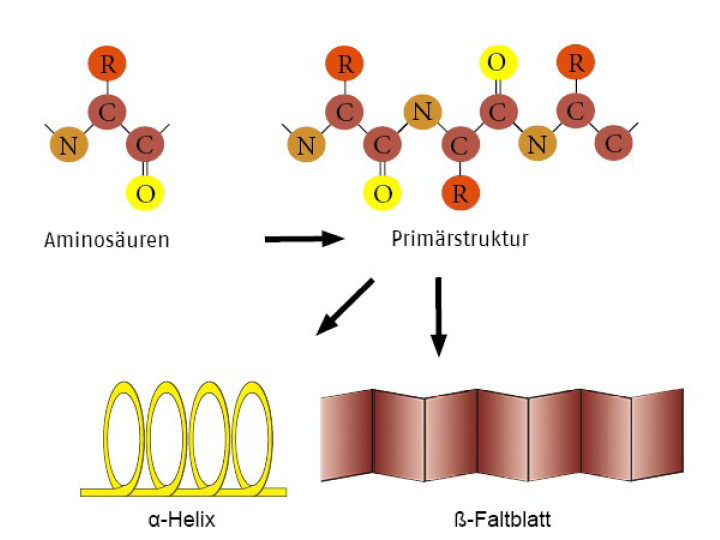
How do horses utilize proteins?
Proteins consist of many contiguous amino acids. These can only be absorbed by the horse if the proteins are completely digested, i.e. the amino acids are split up single, not chain-like. Furthermore, horses only utilise amino acids in the small intestine. This means that only those are available to the horse that were previously unlocked or rebuilt. All others get unused into the large intestine and have to be metabolized here, which puts a strain on liver and kidney.
For example, horses can digest 20 to 74 percent of the amino acids from horse hay. The value fluctuates so much because it depends on whether the hay was cut early or late. When cut late, the stems are already heavily woody and the proteins, which consist of amino acids, are firmly bound to the cell walls. This means that the proteins can only partially be broken down into individual amino acids in the small intestine and are therefore only partially available to the horse. However, the typical horse hay is usually a later first cut with high crude fibre and rather low fructan and sugar contents. Therefore, it is important to ensure an adequate part of easily digestible proteins or amino acids in every feed ration.

What are essential amino acids?
The horse cannot produce three amino acids itself; they must be supplied completely. These are lysine, methionine and threonine. In addition, these three are first limiting. This means that if one of these three amino acids is not available enough, the others cannot be metabolized (Liebig's barrel principle/Liebig’sches Fass).
Studies show that especially on lysine, methionine and threonine might be caused deficiency symptoms. In foals, the first limiting amino acids are lysine, followed by methionine and cysteine. One more reason for a special value on sufficient and high-quality proteins and amino acids at feeding foals.
What are first limiting amino acids?
The horse cannot produce three amino acids itself; they must be supplied completely. These are lysine, methionine and threonine. In addition, these three are first limiting. This means that if one of these three amino acids is not available enough, the others cannot be metabolized (Liebig's barrel principle/Liebig’sches Fass). Studies show that especially on lysine, methionine and threonine might be caused deficiency symptoms. In foals, the first limiting amino acids are lysine, followed by methionine and cysteine. One more reason for a special value on sufficient and high-quality proteins and amino acids at feeding foals.
- Lysine is especially important for breeding horses, responsible for cell division and growth, it is as important for the development of young horses as it is for nursing mares.
- Methionin has an antioxidant effect, it contributes to the formation of many substances, for example creatine, which is important for the hoof horn.
- Threonine contributes to the formation of enzymes and hormones, it is also needed for the formation of antibodies.
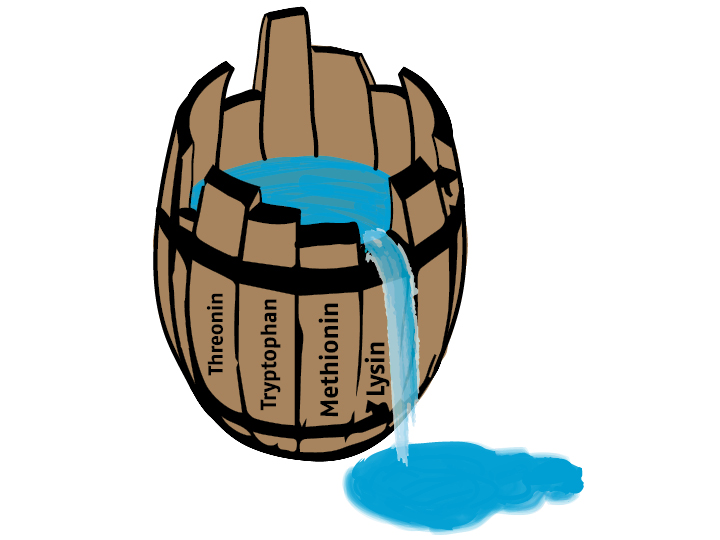
The minimum law states that the growth of an organism is restricted by the most scarce resource. A barrel named after the chemist Justus Liebig is often used as a model: it has staves of different lengths and can only be filled up to the height of the shortest stave. In the same way, an organism can only develop as far as the scarcest resource permits.
Absorption of the small intestine
The horse must absorb the essential amino acids in the small intestine in sufficient quantities directly from the feed to cover its needs. However, some of the essential amino acids in the large intestine are also produced by the horse's intestinal bacteria. But in the large intestine the body cannot absorb them sufficiently. This means: no more positive effect on the organism.
Which feed covers the needs?
The horse’s requirement of essential amino acids can be covered either by natural individual feed such as brewer's yeast, linseed, alfalfa and soy, or by pure amino acids. At marstall they are available in both forms. On the subject of soy, many people here think directly of genetically modified food. Not so at marstall, because both German manufacturers of marstall are members of the "Verband Lebensmittel ohne Gentechnik e.V.". (VOLG), produce according to its standards and their productions are VLOG-certified.
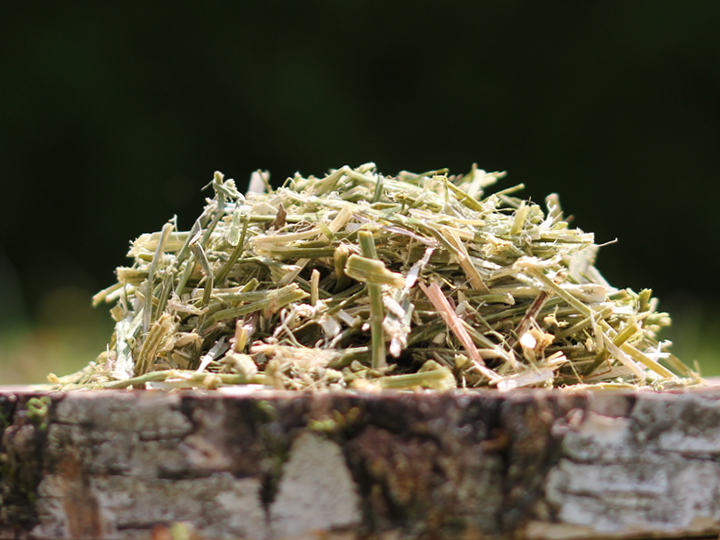
What are the advantages of pure amino acids?
The alternative to natural products is feeding pure amino acids. The great advantage of pure amino acids is that they can be 100% absorbed and used by the horse. Here the horse owner sure knows that the essential amino acids required can already be assumed in the small intestine area. Pure amino acids are used in the marstall products Amino-Muskel PLUS, Amino-Sport Müsli, Condición, Western Struktur-Müsli and the products of the Stud Line, for example.
By the way
Did you know that marstall has been a pioneer in the field of amino acids for years? We know how important high-quality proteins and readily available amino acids are for horses and we put this knowledge into practice in our product recipes. We even received the Equitana Innovation Award in 2015 for our marstall Amino-Sport.
Literatur
- „Pferdefütterung“, Helmut Meyer, Manfred Coenen, Enke Verlag
- „Fohlengesundheit durch richtige Fütterung“, Franziska Vogl, Dirk Winter, Birgit Jostes, Hochschule für Wirtschaft und Umwelt Nürtingen-Geislingen
- https://weiterbildung-pferd.de/2017/07/17/fohlengesundheit-durch-richtige-fuetterung/
- Nutrient Requirements of Horses, National Research Council oft he National Academies, 2007
- Empfehlungen zur Energie- und Nährstoffversorgung von Pferden, GfE, 2014

